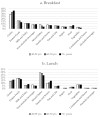Nutrient Intakes from Meals and Snacks Differ with Age in Middle-Aged and Older Americans
- PMID: 31181765
- PMCID: PMC6627320
- DOI: 10.3390/nu11061301
Nutrient Intakes from Meals and Snacks Differ with Age in Middle-Aged and Older Americans
Abstract
The present study investigated the meal patterns across demographic characteristics in middle-aged and older US adults. Study participants were noninstitutionalized participants from the 2005-2016 National Health and Nutrition Examination Survey, an observational cross-sectional study. Data from 17,361 adults were categorized into 45-59 years (n = 7366), 60-70 years (n = 5348), and 71+ years (n = 4647) to compare demographics, nutrient intakes, and meal patterns. Dietary recalls were collected using the multiple-pass method. Data analyses were weighted to create a nationally representative sample. Two-thirds of adults reported consuming three meals on the day of intake. Lunch was the most often skipped meal across all age groups. A greater proportion of adults over 70 years reported consuming breakfast, while a smaller proportion reported consuming snacks. Significant differences were observed in total energy and nutrient intakes and proportion of the day's intakes by meal. Grain, milk, and dairy food group intakes were highest at breakfast, while the protein food group intakes were highest at lunch and dinner. Age-related differences in meal consumption and composition provide valuable formative data to support targeted nutritional education and intervention opportunities to promote and encourage healthy food choices.
Keywords: NHANES; aging; breakfast; dietary intakes; dietary patterns; dinner; lunch; meal patterns; middle-aged adults; snack intakes.
Conflict of interest statement
S.S.J., M.L. and O.J.K. are Abbott Nutrition employees and hold Abbott stock. C.A.T and J.L.K.-S. received research support to the University to support the work. C.A.T. received speaking honorarium and travel expenses from Abbott. All authors were involved in data preparation and publication decisions.
Figures


References
-
- Parsons T.J., Papachristou E., Atkins J.L., Papacosta O., Ash S., Lennon L.T., Whincup P.H., Ramsay S.E., Wannamethee S.G. Healthier diet quality and dietary patterns are associated with lower risk of mobility limitation in older men. Eur. J. Nutr. 2018:1–9. doi: 10.1007/s00394-018-1786-y. - DOI - PMC - PubMed
-
- Shlisky J., Bloom D.E., Beaudreault A.R., Tucker K.L., Keller H.H., Freund-Levi Y., Fielding R.A., Cheng F.W., Jensen G.L., Wu D., et al. Nutritional considerations for healthy aging and reduction in age-related chronic disease. Adv. Nutr. 2017;8:17–26. doi: 10.3945/an.116.013474. - DOI - PMC - PubMed
Publication types
MeSH terms
Grants and funding
LinkOut - more resources
Full Text Sources
Medical

